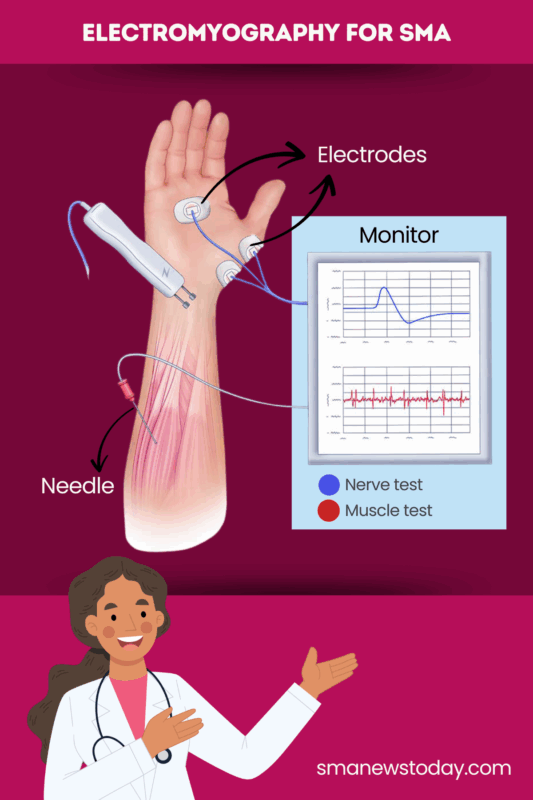Electromyography for spinal muscular atrophy
Last updated June 23 2025, by Marisa Wexler, MS

Spinal muscular atrophy (SMA) is a genetic disorder that’s characterized by progressive muscle weakness and wasting due to the death of motor neurons, the nerve cells that control muscle movement.
Electromyography, often abbreviated EMG, is a diagnostic test that measures the electrical activity of muscles. EMG can be used to detect SMA-related changes in muscles and the motor neurons that control them.
Role of EMG in diagnosing SMA
SMA is a neuromuscular disorder that is mainly caused by mutations in the SMN1 gene, which provides instructions to make a protein called survival motor neuron, or SMN. Everyone inherits two copies of the SMN1 gene; SMA is an autosomal recessive disorder, meaning the disease only develops if both SMN1 gene copies are mutated.
In SMA, SMN1 mutations lead to deficiency of the SMN protein, which as its name implies is essential for motor neuron health. Without enough functional SMN protein, motor neurons sicken and die, which ultimately drives disease symptoms. The different types of SMA are based on the age at which symptoms first appear, but all are marked by gradual loss of motor neurons.
Normally, electrical activity in motor neurons triggers a release of signaling molecules to muscle cells, which ultimately leads to muscle contraction. In SMA, the sickening of motor neurons causes this process to be impaired, leading to characteristic changes in EMG readings that indicate poorer connections between motor neurons and muscles.
Because it can detect these characteristic changes in motor neurons, EMG has historically been one of the main tools used to diagnose SMA. However, with modern advances in genetic testing, nowadays the main method for diagnosing SMA is genetic tests to look for disease-causing mutations in the SMN1 gene.
Genetic testing has some notable advantages over EMG as a diagnostic tool for SMA. Since it can pinpoint the specific disease-causing mutation, genetic testing can usually provide a definitive diagnosis, whereas EMG abnormalities seen in SMA may also be seen in other neuromuscular disorders, necessitating additional testing to rule out those other conditions.
Genetic testing can also be used to look for other genetic conditions and for prenatal testing to see if a developing fetus has SMA, which can be especially useful in people with a known family history of the disease. In addition, genetic testing can detect the copy number of the SMN2 gene — a gene that functions as a sort of backup for the SMN1 gene — which can aid in predicting forms of SMA before symptoms appear.
Although it is not the primary tool used for SMA diagnosis, EMG still plays an important role in SMA testing. This technique may be important in diagnosing atypical cases and rare types of SMA with causes other than mutations in the SMN1 gene.
EMG can often get results more quickly than genetic testing, so it may be used as an early test to point toward SMA in patients who have not yet been diagnosed. In people already diagnosed, EMG can provide information about the severity of disease progression, which may help to guide care decisions. There’s also emerging evidence that EMG can be used to help track how patients are responding to treatment for SMA.
What to expect during an EMG test
During an EMG test, a healthcare provider will insert a small needle with an electrode into the muscle that is being tested. The needle is connected by wires to a computer.
As the patient contracts or relaxes their muscles, the electrical activity of the muscles will be detected by the electrode and transmitted to the computer, appearing as waves on the screen; sometimes there is also a sound signal to help providers track outcomes. The provider can interpret these signals to look for the presence and severity of SMA-related abnormalities.
Prior to undergoing an EMG test, it’s recommended that patients bathe and wear comfortable, loose-fitting clothing. Patients should avoid putting cream, lotion, or perfume on their skin, and should generally avoid using nicotine products or ingesting caffeine for a few hours before the test, as these can affect the test’s accuracy. It’s also important for patients to tell their healthcare provider if they are taking blood thinner medications or have electrical medical devices such as a pacemaker.
During the test itself, patients will usually sit or lie down. The provider will then insert the needle into the muscle being tested; there may be some pain or discomfort as the needle is inserted into the muscle. Then the provider will instruct the patient to flex, move, or relax their muscle as the provider records data. Once enough data are recorded — which usually takes only a minute or two for each muscle — the needle will be removed, and then other muscles may be similarly tested as necessary.
An EMG test usually takes 60 to 90 minutes in total, depending on how many muscles are tested. After the test, patients may experience some bruising or bleeding where the needles were inserted. Tenderness or soreness in the tested muscles also may occur after the test, but usually resolve in less than a week.

Interpreting EMG results for SMA
EMG for SMA can reveal several characteristic changes that are indicative of the disease. These include:
- signs of active denervation, meaning loss of nerve supply to muscle cells
- signs of reinnervation, where muscles and motor neurons try to re-form connections
- enlargement of motor unit action potentials, where electrical activity is higher in an attempt to compensate for reduced motor neuron signaling
- fibrillation potentials, which are abnormal spikes of spontaneous electrical activity in muscle that occur when muscles become disconnected from motor neurons
- jitter and blocking, where communication between nerves and muscles is abnormal in assessments of single muscle fibers.
Generally, EMG provides information when it’s used on muscles that are already showing signs of weakness. Especially in people with SMA types 3 or 4, which are milder forms of the disease, EMG of unaffected muscles may not reveal any notable changes. It’s therefore very important to interpret EMG findings within the context of the patient’s clinical situation, including data from functional assessments and other medical tests.
Limitations of EMG testing for SMA
EMG is useful for detecting changes that are caused by SMA disease progression, but this means that EMG may not reveal any abnormalities when used at very early stages of the disease. Most data on EMG for SMA come from people in relatively more advanced stages of the disease.
In the modern era, with advances in genetic testing and new SMA treatments, EMG is less commonly used as part of routine SMA workup. For instance, in people who are diagnosed with SMA and are stably on treatment, EMG may not be required as long as patients are retaining their motor function abilities. Also, EMG requires some expertise to interpret as well as specialized equipment to conduct, so this type of testing may not be available for everyone.
SMA News Today is strictly a news and information website about the disease. It does not provide medical advice, diagnosis, or treatment. This content is not intended to be a substitute for professional medical advice, diagnosis, or treatment. Always seek the advice of your physician or other qualified health provider with any questions you may have regarding a medical condition. Never disregard professional medical advice or delay in seeking it because of something you have read on this website.
Recent Posts
Related articles
-
December 11, 2025 by Cherie Ehlert
Guest Voice: Instead of counting months, we’re focused on years







